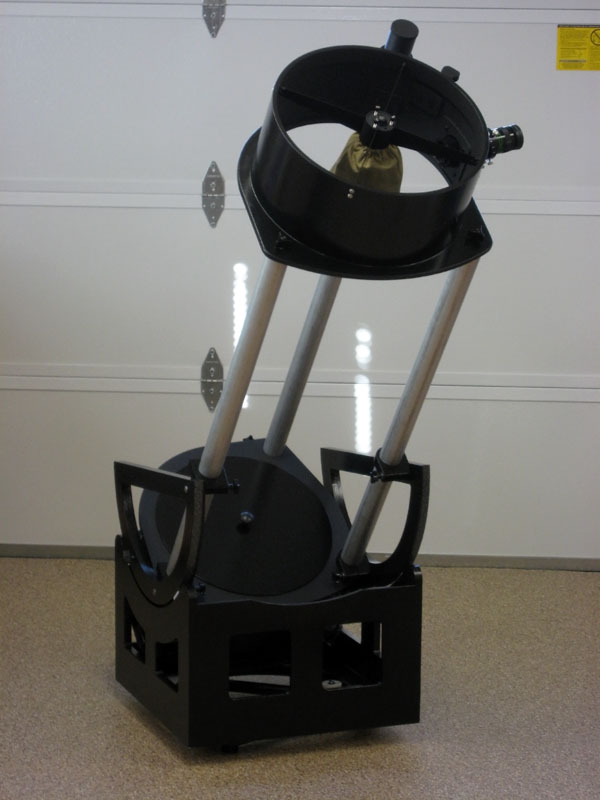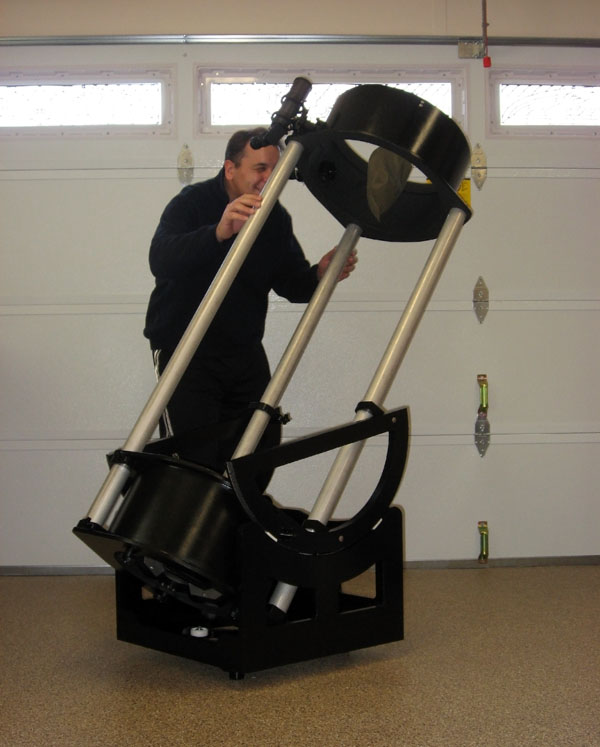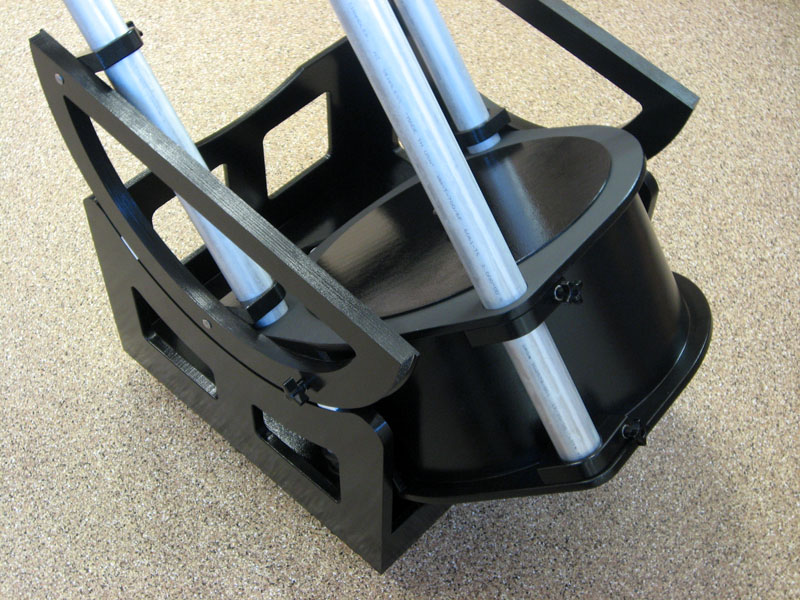GSSP turned out to be a terrific star party, and I would like to start this report by personally thanking our hosts, the Albaugh family, as well as all the volunteers who made this event such a great success!
The conditions were good all 4 nights. The NELM hovered in the 6.8/7.0 range. Given the amount of haze that was clearly visible during the day, and especially shortly after sunset, I feel that the site used for GSSP could easily yield mag. 7.2 or better skies when the air is drier. The seeing was average most of the time, although a bit off on the first and the last night.
I had prepared a list of 58 objects drawn mostly from the Herschel II, DeepMap 600 and Tac Eye Candy lists. I also added a few Palomar globular clusters and obscure summer time planetaries, just for the heck of it. I ended up logging 48 new objects. Below is my log for all 4 nights. See you at GSSP!
Location: Adin, CA [Elevation 4200 ft]
Telescope: Meade Lightbridge 12″ F/5
Eyepieces used:
- Televue Panoptic 27mm (56x - 1.2° TFOV)
- Televue Nagler 16mm type 5 (95x - 52′ TFOV)
- Televue Nagler 9mm type 6 (169x - 29′ TFOV)
- Televue Nagler 7mm type 6 (217x - 22′ TFOV)
- Televue Nagler 5mm type 6 (305x - 16′ TFOV)
Log format: [designation(s)] [type] [constellation] [RA] [Dec] [magnitude] [date and local time (PDT)]
NGC 6070 GX Ser 16 10 33 +00 40 55 12.4 07-10 10:40pm
Fairly faint, relatively uniform, diffuse halo about 3′x1.5′ ENE-WSW. Faint stellar nucleus glimpsed using averted vision. Located 8′ SSE of a bright (mag. 6.7) yellow star. Two moderately faint stars were seen just outside the eastern end of the halo. PGC 57350 was detected as a small and very faint smudge 5′ ENE.
NGC 6106 GX Her 16 19 20 +07 23 10 12.8 07-10 10:55pm
1′x45″ NNW-SSE, fairly faint, relatively uniform, very slightly brighter core, faint stellar nucleus or superimposed star glimpsed using averted vision. Extremely faint star (mag. 14.4!) at the northern end, just outside the halo. Slightly brighter star (mag. 14.6!) located 1′ S. The difference in the appreciation of their brightness is probably due to the fact that the first one is actually superimposed over the halo. Two fairly bright field stars are 10′ SSW and SW.
NGC 6181 GX Her 16 32 50 +19 48 22 12.2 07-10 11:05pm
1.5′x1′ NNE-SSW. Fairly bright small core or stellar nucleus. Moderately faint diffuse halo which appears uneven. Traces of a spiral arm extending NNE, and possibly a smaller and dimmer symmetrical one. Extremely faint superimposed star at the northern end (about 45′ N of nucleus)
B 92 (Black Hole) DN Sgr 18 16 09 -18 10 45 O6 07-11 12:10am
Superimposed over the Small Sagitarius Star Cloud (M24) and visible in the same field of view of the Televue Panoptic 27mm with B93 and NGC 6603, this dark nebula measures 15′x8′, is oriented roughly N-S, and features a single fairly bright superimposed star located just E of the center.
Palomar 8 GC Sgr 18 42 10 -19 48 56 10.9 07-11 12:20am
Round, about 1.5′ in diameter, moderately faint, uniform and unresolved smudge. Moderately faint star just south (?). 3 or 4 stars, either superimposed field stars or physically belonging to the cluster, were detected.
IC 1295 PN Sct 18 55 14 -08 48 46 12.7 07-11 12:45am
Visible at 95x without filter and with globular cluster NGC 6712 in the same field of view. At 217x + OIII filter, I see a faint roundish disk about 2′ in diameter, relatively uniform with traces of annularity.
NGC 6717 (Palomar 9) GC Sgr 18 55 46 -22 41 13 8.4 07-11 01:00am
About 45″x30″ E-W, moderately faint. Half a dozen stars are resolved. Located 2′ S of a bright yellow/orange star.
NGC 6814 GX Aql 19 43 17 -10 17 48 12.1 07-11 01:35am
Moderately bright almost stellar core. Faint, round, diffuse halo, about 2′ in diameter, showing hints of mottling. Faint superimposed star 30″ W.
Palomar 11 GC Aql 19 45 50 -07 58 45 9.8 07-11 01:45am
Very faint round haze with a dozen superimposed field stars extending over an area roughly 5′ in diameter. Located just 6′ SSE of a fairly bright (mag. 8.6) field star.
NGC 6907 GX Cap 20 25 46 -24 46 17 11.9 07-11 01:50am
Moderately faint core, about 30″ in diameter. Faint halo, about 2′x1.2′ extending E-W. A small and faint detached knot is visible just NE of the core. Using averted vision, it’s pretty clear that it’s a spiral arm.
NGC 6991 OC Cyg 20 55 17 +47 27 25 07-11 02:15am
Roughly 60 fairly bright stars of similar brightness within an area 30′ in diameter. A couple of chains, each made up of 5 or 6 stars, are visible in the western half. A bright, slightly yellow star is located at the eastern end of the cluster.
M 2-9 (Minkowski’s Butterfly) PN Oph 17 06 15 -10 09 26 13.2 07-11 10:40pm
Extremely faint nebulosity, extending approximately 30″x10″ N-S. The central star is moderately faint. For some reason, the use of an O-III filter did not seem to help much.
NGC 6309 (Box Nebula) PN Oph 17 14 42 -12 55 22 11.6 07-11 10:50pm
Appears as an out of focus star at 95x. Blinks well using an O-III filter. Best seen at 305x. Measures roughly 20″x12″ extending NNW-SSE. Fairly uniform. The northern half seems a bit brighter. A moderately faint (mag. 11.5) star is located 15″ NNW. A very faint (mag. 15.0) star is 45″ E. Finally, an extremely faint star is located just 5″ W (?)
NGC 6340 GX Dra 17 10 17 +72 17 38 12.0 07-11 11:05pm
Moderately bright stellar nucleus. Gradually fainter round diffuse halo about 1.5′ in diameter. Faint galaxy (IC 1251) about 7′ NNW seen easily. Another one (IC 1254), just barely seen, is located 10′ NE.
NGC 6507 OC Sgr 18 00 29 -17 27 01 9.6 07-11 11:30pm
Sparse group of two dozen moderately bright to fairly faint stars in an area measuring roughly 10′ in diameter.
IC 1276 (Palomar 7) GC Ser 18 11 21 -07 12 37 10.3 07-11 11:35pm
Extremely faint round smudge, about 2′ in diameter, seen using averted vision only, and surrounding two fairly faint stars separated by about 45″ on an E-W line. An extremely faint star is located 1.2′ E. Two moderately bright stars are roughly 3.5′ N and NNE respectively.
NGC 6596 OC Sgr 18 18 12 -16 38 43 07-11 11:45pm
Two dozen fairly bright to moderately faint stars within an area 10′ in diameter. Not very well detached from that part of the Milky Way. A dozen stars are arranged in a “C” shape.
NGC 6604 OC Ser 18 18 40 -12 14 12 7.5 07-12 12:00am
5 fairly bright stars arranged in a trapezoidal shape roughly 2′x1′ E-W, the brightest member being slightly yellow. A few slightly dimmer stars are spread out within a few arc minutes.
NGC 6631 OC Sct 18 27 48 -12 01 21 11.7 07-12 12:05am
About 20 fairly faint stars within 5′. Another small group is located about 10′ SE. Is it part of the same cluster?
NGC 6819 OC Cyg 19 41 42 +40 12 45 9.5 07-12 01:10am
About 25 moderately faint stars over a milky background within an area 4′ in diameter. A round dark region about 2′ in diameter is very obvious in the northern half of the cluster. A bright (mag. 6.2) yellow star is located 10′ ENE while a bright (mag. 6.9) white star is only 14′ SSE.
NGC 6857 PN Cyg 20 02 16 +33 34 13 11.4 07-12 01:20am
Faint round nebulosity about 30″ in diameter, relatively uniform, very slightly brighter in its center. Without an O-III filter, the nebula is not very obvious, but a fairly faint superimposed star, slightly offset to the north, is visible. Is this the central star? Two moderately faint stars are located on either sides of the nebula on a NE-SW line. At 217x with an O-III filter, the nebula gives the impression of having an odd triangular shape, the northern side being flat…
NGC 6894 PN Cyg 20 16 51 +30 35 54 14.4 07-12 01:35am
Round, about 45″ in diameter, fairly faint. Shows traces of ring structure, the central region, about 10″ in diameter, being slightly darker. A knot is visible on the ring in the NNE direction. Since it almost completely disappears when using an O-III filter, it most likely is a superimposed star.
Abell 70 PN Aql 20 32 09 -07 03 01 14.3 07-12 01:45am
Ghostly smudge, barely visible using averted vision and an O-III filter. Seems round and uniform. It is also visible without a filter once you know exactly where to look. A moderately bright (mag. 11.1) star is located 3.5′ E.
NGC 7129 OC Cep 21 43 16 +66 09 38 11.5 07-12 02:35am
5 moderately bright stars and 2 faint stars within an area measuring 5′. Some nebulosity can be seen around the brightest stars. Since that nebulosity seems to disappear entirely when using an O-III or UHC filter, it probably is a reflection nebula associated with this young cluster.
NGC 7139 PN Cep 21 46 28 +63 50 21 13.5 07-12 02:45am
Faint, round and uniform nebulosity about 1′ in diameter. A moderately faint (mag.. 14.4) lies just outside the nebula in the SSE direction.
NGC 6530 OC Sgr 18 05 12 -24 21 27 5.1 07-12 11:00pm
Roughly 40 stars, most of which are fairly bright, within an area 10′ in diameter. This cluster is embedded inside M8, the famous Lagoon Nebula, and is likely physically related. There is a tight double on the eastern side.
NGC 6546 OC Sgr 18 08 03 -23 17 42 8.2 07-12 11:10pm
Seen as a faint smudge in 9×50 finder scope. Fairly inconspicuous, round, measuring about 15′ in diameter, this cluster contains two dozen moderately bright stars and at least as many faint stars over a milky background. There is a tight double at the western end.
IC 4634 PN Oph 17 02 13 -21 50 30 12.0 07-12 11:40pm
Appears as an out of focus star, even at 305x. Blinks well using an O-III filter. Roundish, about 10″ in diameter, extremely slightly elongated N-S, fairly bright and uniform. Possible sighting of an extremely faint envelope extending 25″ in diameter (although this may just be scattering).
NGC 6548 GX Her 18 06 29 +18 35 23 12.7 07-12 11:40pm
Very faint round diffuse halo, about 1.5′ in diameter. Moderately bright core 30″x20″ elongated NNW-SSE - this galaxy appears to be a face on barred spiral. An extremely faint superimposed star is located 1′ ESE, and another one is 1.2′ ENE. Very faint NGC 6549 is visible in the same field of view.
NGC 6058 PN Her 16 04 50 +40 39 21 13.0 07-13 12:10am
Moderately bright, uniform, very slightly elongated N-S, about 25″ in diameter. Fairly bright central star. Located inside an equilateral triangle formed by 3 fairly bright stars.
NGC 6155 GX Her 16 26 28 +48 20 46 13.2 07-13 12:25am
1.2′x50″ elongated NW-SE. Fairly faint and uniform, only slightly and gradually brighter towards the center.
Palomar 6 GC Oph 17 44 24 -26 13 42 11.6 07-13 12:30am
Not seen with 12″ scope. Using Mark Johnston’s 18″ F/3.7 StarMaster telescope at 216x, this globular cluster shows as an extremely pale glow.
NGC 6804 PN Aql 19 32 07 +09 14 58 12.4 07-13 12:50am
Faint round glow about 1′ in diameter. 3 superimposed stars are visible on an E-W line. I suspect the one in the center to be the central star that gave birth to this planetary nebula. Using an O-III filter, traces of annularity seem to be visible, especially in the northern region (?)
NGC 6793 OC Vul 19 23 43 +22 09 49 07-13 01:00am
I counted 35 stars within an area 8′ in diameter, 20 of which are fairly bright. Slightly elongated NNE-SSW.
NGC 6800 OC Vul 19 27 35 +25 09 46 07-13 01:05am
30 fairly bright stars and at least as many faint stars located within 14′. Pretty sparse with large areas free of stars. This cluster is also named the “Sea Turtle” cluster.
NGC 6824 GX Cyg 19 43 57 +56 08 07 13.0 07-13 01:35am
Fairly bright core measuring about 30″x20″ elongated NE-SW. Faint halo extending 1′x40″ in the same direction. Very faint superimposed star at the SW end of the halo. Moderately faint field star 30″ N.
NGC 7026 (Cheeseburger Nebula) PN Cyg 21 06 42 +47 53 38 12.0 07-13 02:05am
Best seen at 610x (Nagler 5mm + Barlow 2x). Located 30″ WSW of a moderately bright (mag. 9.6) star, this nebula is composed of 2 moderately bright lobes oriented NE-SW separated by a dark lane, hence the name of “Cheeseburger Nebula”…
NGC 7031 OC Cyg 21 07 35 +50 55 03 11.0 07-13 02:30am
About 20 moderately bright stars within 5′. A nice red star is easily noticeable at the northern end of this cluster.
NGC 7048 PN Cyg 21 14 40 +46 19 55 11.0 07-13 02:40am
Faint uniform disk 1′ in diameter. Faint superimposed star or knot at the NNW boundary. Located just north of a moderately bright (mag. 10.2) star.
NGC 6166 GX Her 16 29 02 +39 31 49 12.9 07-13 10:40pm
Moderately faint, measuring about 45″, very slightly elongated NE-SW, gradually brighter towards its center. This elliptical galaxy is the brightest member of the cluster of galaxies Abell 2199. Many members of that cluster are visible in the same field of view.
NGC 6239 GX Her 16 50 27 +42 43 25 12.9 07-13 10:50pm
1′x30″ E-W, moderately faint, gradually brighter towards its center. Using Tom Osypowski’s 30″ F/3.3 telescope, this galaxy appears much bigger and brighter but fails to show additional details.
IC 4756 OC Ser 18 39 33 +05 27 39 5.4 07-13 11:45pm
Seen naked eye as a faint smudge! Using a Panoptic 27mm (65x, 1.2 deg TFOV), this cluster shows about 40 fairly bright stars in an area measuring roughly 30′ in diameter. A group of stars near the center delimit an oval region measuring 8′x4′ NE-SW that is almost devoid of stars. Half a dozen stars form a chain to the ENE. Finally, there is a small group of 6/7 stars to the WNW that seems to be a region of higher density in this cluster.
NGC 6760 GC Aql 19 11 46 +01 03 02 9.0 07-14 12:00am
This globular cluster measures about 3′ in diameter. The core region is moderately bright and measures about 1′. A few individual stars located in the outer region pop in and out of view.
NGC 6772 PN Aql 19 15 11 -02 41 13 14.0 07-14 12:10am
Best seen using an O-III filter. Very dim, round, about 1′ in diameter, fairly uniform with maybe traces of annularity (?)
NGC 6778 PN Aql 19 19 00 -01 34 32 13.3 07-14 12:20am
Fairly bright, 20″x15″ E-W, uniform. Appears slightly rectangular, with the central section being a little narrower.
NGC 6765 PN Lyr 19 11 33 +30 33 51 12.9 07-14 12:55am
Appears as a fairly bright bar measuring 30″x15″ NE-SW embedded inside a very faint round glow about 35″ in diameter.
B 142 DN Aql 19 40 14 +10 32 33 O5 07-14 01:15am
Best seen using a Panoptic 27mm (65x, 1.2 deg TFOV). Large dark nebula, about 40′x10′ WNW-ESE, located in a moderately dense region of the Milky Way. The eastern half is wider and less dense as a larger number of stars shine through. In particular, two fairly bright stars shine through, one to the NE and one to the SE.
NGC 6811 OC Cyg 19 37 38 +46 24 48 9.0 07-14 01:30am
Detected in 9×50 finder scope. Contains about 50 moderately bright stars within an area 12′ in diameter. Several dark areas/lanes can be seen throughout. Appears fairly conspicuous due to its much higher density than the surrounding area.


